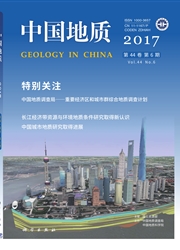

 中文摘要:
中文摘要:
梅山铁多金属矿床是宁芜盆地内代表性矿床之一,其Fe-Cu-Au-Mo矿化与辉长闪长玢岩密切相关。本文对含矿辉长闪长玢岩及矿体下部的新鲜辉长闪长玢岩进行LA-MC-ICP-MS锆石U-Pb定年,获得年龄分别为(137.8±1.7)Ma、(141.2±1.0)Ma。因此辉长闪长玢岩形成时间应在138-141 Ma,伴随的Fe-Cu-Au-Mo矿化稍晚,都属于早白垩世,受区域岩石圈伸展和减薄作用制约。根据年代学和地质事实证据,初步认为宁芜盆地早白垩世火山活动从北段开始,火山活动持续时间至少为7-10 Ma。辉长闪长玢岩中古老锆石年龄变化于1898-1903 Ma、1163 Ma和292-296 Ma,时代分别为古元古代、新元古代和早二叠纪,暗示着岩浆上侵过程中基底岩石对岩浆可能有混染作用,表明长江中下游成矿带存在早元古代结晶基底和中—晚元古代褶皱基底的"双层结构"。
 英文摘要:
英文摘要:
The Meishan polymetallic iron deposit is one of the representative deposits in Ningwu Basin, with its Fe-Cu-Au-Mo mineralization related closely with the gabbro-diorite porphyry. In this paper, the authors conducted LA-MC-ICP-MS zircon U- Pb dating of the ore-bearing gabbro-diorite porphyry and the fresh gabbro-diorite porphyry under the orebody, and obtained the U- Pb ages of (137.8±1.7) Ma and (141.2± 1.0) Ma, respectively, suggesting that the gabbro-diorite porphyry was formed in 138- 141Ma, the accompanying Fe-Cu-Au-Mo mineralization might have taken place later, and both occurred in Early Cretaceous, constrained by a tectonic regime extension and lithospheric thinning environment. Depending on the chronology and geological facts evidence, the authors put forward a new viewpoint that the volcanic-magmatism of Ningwu Basin began from the north and lasted for 7-10 Ma at least. The U-Pb ages of the older zircons from the gabbro-diorite porphyry range from 1903 to 1898 Ma, 1163 Ma and 296 to 292 Ma, suggesting Paleoproterozoic, Neoproterozoic and Early Permian. These data imply that the basement rocks made some contribution to the magmatism and there existed the so-called double layer structure of the Paleoproterozoic crystalline basement plus the Mesoproterozoic-Neoproterozoic fold basement in the Middle-Lower Yangtze River valley metallogenic belt (YRB).
 同期刊论文项目
同期刊论文项目
 同项目期刊论文
同项目期刊论文
 期刊信息
期刊信息
